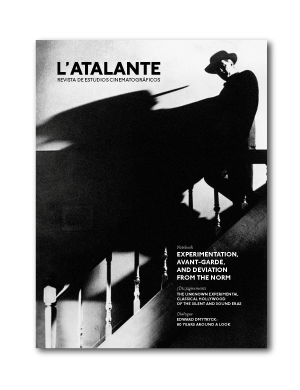Vanishing Points
Myth, Atmosphere, Territory: a Cinematographic Hypothesis of the Name 'America'
Published 2019-01-31
Keywords
- Myth,
- Atmosphere (film),
- Mood (film),
- Territory (film),
- Proper Name
- Philosophy of Film ...More
How to Cite
Dominguez Jimenez, R. (2019). Myth, Atmosphere, Territory: a Cinematographic Hypothesis of the Name ’America’. L’Atalante. Journal of Film Studies, (27), 187–200. https://doi.org/10.63700/647
Copyright (c) 2019 L'Atalante. Journal of film studies

This work is licensed under a Creative Commons Attribution-NonCommercial-NoDerivatives 4.0 International License.
Abstract
This article offers a philosophical exploration of the concept of cinematographic territory. It draws on the concept of territory formulated by Deleuze and Guattari to propose that cinematographic territory is not a montage of spatial, geographical or scenic features with a diegetic or representative function, but an effect of appropriation and presence that occurs when the mise-en-scene, by means of a feature referred to here as cinematographic atmosphere, gives rise to a cosmic drama. All territorial human appropriation implies the endowment of a place or topos with a proper name, but this endowment also signifies a mythical foundation. Cinematographic territory is mythical because the identification of expressive forces that it brings together involves the vindication of, or the search for, a foundational name. The proper name that links cinema to political history would thus be America, which is not only a landmass or a contentious cultural reality, but a cinematographic myth with multiple variations.Downloads
Download data is not yet available.
References
Aristóteles (1974). <em>Poética. </em>Madrid: Gredos.<br>
Arnauld, A., Nicole, P (1992). <em>La logique ou l’art de penser.</em> París: Gallimard.<br>
Bazin, A. (2002). <em>Qu’est-ce que le cinema ?. </em>París: Cerf.<br>
Benjamin, W. (2008). <em>Obras, libro I, vol. 2. </em>Madrid: Abada.<br>
Debord, G. (1955). Introduction à une critique de la géographie urbaine. <em>Les lèvres nues, 6</em>. Recuperado de https://www.larevuedesressources.org/introduction-a-une-critique-de-la-geographie-urbaine,033.html<br>
Deleuze, G. (1984). <em>Francis Bacon. Logique de la sensation. </em>París: La différence.<br>
— (1983). <em>L’Image-mouvement. Cinéma 1</em>. París: Minuit.<br>
— (1985). <em>L’Image-temps. Cinéma 2</em>. París: Minuit.<br>
— (1989). <em>Lógica del sentido</em>. Barcelona: Paidós.<br>
Deleuze, G., Guattari, F. (2010). <em>Mil Mesestas. Capitalismo y esquizofrenia 2</em>. Valencia: Pre-Textos.<br>
Déotte, J.-L. (1998). <em>L’Homme de verre. Esthétiques benjaminiennes.</em> París: L’Harmattan.<br>
Derrida, J. (1995). <em>Mal d’Archive. Une impression freudienne</em>. París: Galilée.<br>
Fiedler, L. (1969). <em>The Return of The Vanishing American. </em>Nueva York: Stein and Day.<br>
Guattari, F. (1996). <em>Caosmosis</em>. Buenos Aires: Manantial. <br>
Jackson, J. B. (1994). <em>A Sense of Place, a Sense of Time.</em> New Haven: Yale University Press.<br>
Korzybski, A. (1933). <em>Science and Sanity: An Introduction to Non-Aristotelian Systems and General Semantics</em>. Brooklyn: Institute of General Semantics.<br>
Kracauer, S. (2016). <em>Ensayos sobre cine y cultura de masas. Escritos norteamericanos. </em>Buenos Aires: El cuenco de plata.<br>
Kripke, S. (1981). <em>Naming and Necessity</em>. Oxford: Blackwell.<br>
Lawrence, D. H. (1920). <em>Studies in Classic American Literature</em>. Londres: Martin Secker.<br>
Lovecraft, H. P. (2012). <em>The Annotated Supernatural Horror in Literature</em>. Nueva York: Hippocampus Press.<br>
Lyotard, J.-F. (1971). <em>Discours, figure</em>. París: Klincksieck.<br>
— (1983). <em>Le différend</em>. París: Minuit.<br>
Monsiváis, C. (2000). <em>Aires de familia. Cultura y sociedad en América Latina</em>. Barcelona: Anagrama.<br>
Pérez, G. (1998). <em>The Material Ghost. Films and their Medium</em>. Baltimore: The Johns Hopkins University Press.<br>
Reyes, A. (1936). Notas sobre la inteligencia americana<em>.</em> <em>Sur, 24</em>,7-15.<br>
Rocha, G. (2011). <em>La revolución es una eztétyka</em>. Buenos Aires: Caja Negra.<br>
Rojas Mix, M. (2015). <em>América imaginaria</em>. Santiago de Chile: Pehuén.<br>
Schmitt, C. (1974). <em>Der Nomos der Erde. Im Völkerrecht des Jus Publicum Europaeum</em>. Berlín: Duncker & Humblot.<br>
Simondon, G. (2006). <em>El modo de existencia de los objetos técnicos</em>. Buenos Aires: Prometeo libros.<br>
Sinnerbrink, R. (2012). <em>Stimmung: exploring the aesthetics of mood</em>. <em>Screen</em>, <em>53</em>(2), 148–163. https://doi.org/10.1093/screen/hjs007 <br>
Tuang, Y.-F. (2014). <em>Space and Place. The Perspective of Experience.</em> Minneapolis: University of Minnesota Press.
Arnauld, A., Nicole, P (1992). <em>La logique ou l’art de penser.</em> París: Gallimard.<br>
Bazin, A. (2002). <em>Qu’est-ce que le cinema ?. </em>París: Cerf.<br>
Benjamin, W. (2008). <em>Obras, libro I, vol. 2. </em>Madrid: Abada.<br>
Debord, G. (1955). Introduction à une critique de la géographie urbaine. <em>Les lèvres nues, 6</em>. Recuperado de https://www.larevuedesressources.org/introduction-a-une-critique-de-la-geographie-urbaine,033.html<br>
Deleuze, G. (1984). <em>Francis Bacon. Logique de la sensation. </em>París: La différence.<br>
— (1983). <em>L’Image-mouvement. Cinéma 1</em>. París: Minuit.<br>
— (1985). <em>L’Image-temps. Cinéma 2</em>. París: Minuit.<br>
— (1989). <em>Lógica del sentido</em>. Barcelona: Paidós.<br>
Deleuze, G., Guattari, F. (2010). <em>Mil Mesestas. Capitalismo y esquizofrenia 2</em>. Valencia: Pre-Textos.<br>
Déotte, J.-L. (1998). <em>L’Homme de verre. Esthétiques benjaminiennes.</em> París: L’Harmattan.<br>
Derrida, J. (1995). <em>Mal d’Archive. Une impression freudienne</em>. París: Galilée.<br>
Fiedler, L. (1969). <em>The Return of The Vanishing American. </em>Nueva York: Stein and Day.<br>
Guattari, F. (1996). <em>Caosmosis</em>. Buenos Aires: Manantial. <br>
Jackson, J. B. (1994). <em>A Sense of Place, a Sense of Time.</em> New Haven: Yale University Press.<br>
Korzybski, A. (1933). <em>Science and Sanity: An Introduction to Non-Aristotelian Systems and General Semantics</em>. Brooklyn: Institute of General Semantics.<br>
Kracauer, S. (2016). <em>Ensayos sobre cine y cultura de masas. Escritos norteamericanos. </em>Buenos Aires: El cuenco de plata.<br>
Kripke, S. (1981). <em>Naming and Necessity</em>. Oxford: Blackwell.<br>
Lawrence, D. H. (1920). <em>Studies in Classic American Literature</em>. Londres: Martin Secker.<br>
Lovecraft, H. P. (2012). <em>The Annotated Supernatural Horror in Literature</em>. Nueva York: Hippocampus Press.<br>
Lyotard, J.-F. (1971). <em>Discours, figure</em>. París: Klincksieck.<br>
— (1983). <em>Le différend</em>. París: Minuit.<br>
Monsiváis, C. (2000). <em>Aires de familia. Cultura y sociedad en América Latina</em>. Barcelona: Anagrama.<br>
Pérez, G. (1998). <em>The Material Ghost. Films and their Medium</em>. Baltimore: The Johns Hopkins University Press.<br>
Reyes, A. (1936). Notas sobre la inteligencia americana<em>.</em> <em>Sur, 24</em>,7-15.<br>
Rocha, G. (2011). <em>La revolución es una eztétyka</em>. Buenos Aires: Caja Negra.<br>
Rojas Mix, M. (2015). <em>América imaginaria</em>. Santiago de Chile: Pehuén.<br>
Schmitt, C. (1974). <em>Der Nomos der Erde. Im Völkerrecht des Jus Publicum Europaeum</em>. Berlín: Duncker & Humblot.<br>
Simondon, G. (2006). <em>El modo de existencia de los objetos técnicos</em>. Buenos Aires: Prometeo libros.<br>
Sinnerbrink, R. (2012). <em>Stimmung: exploring the aesthetics of mood</em>. <em>Screen</em>, <em>53</em>(2), 148–163. https://doi.org/10.1093/screen/hjs007 <br>
Tuang, Y.-F. (2014). <em>Space and Place. The Perspective of Experience.</em> Minneapolis: University of Minnesota Press.

